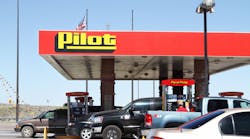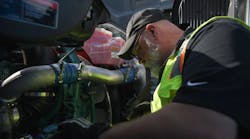All vehicle fleets, regardless of fleet size, type of vehicles and their application, seek ways to simplify processes and control costs, especially with regard to fuel. Fuel, typically, is one of the largest operating expenses for a fleet.
To help manage and reduce fuel expenses, it is necessary to accurately track fuel use and costs. Being able to see where its fuel is “seeping through the cracks” enables a fleet to take the suitable measures to remedy any problems.
The foundation for this is to develop and successfully implement effective controls and oversight for managing fuel use.
Fleet fuel cards can help with this. They are a way to closely monitor fuel type, time of fueling transactions, number of gallons purchased and more, say fleet fuel card providers. Moreover, the cards can be used to put safeguards in place to keep fleets from experiencing fuel theft and fraud.
Another benefit is that these cards are customizable on a card-by-card basis. This permits a fleet to control spending limits – including the types of purchases an employee can make, how much fuel can be purchased per day, fuel limits by vehicle type and/or tank capacity, types of fuel that can be bought or whatever parameters would assist control efforts. The desired level of monitoring and reporting can be set well.
Some fleet cards provide per gallon fuel discounts if purchases are made at affiliated vendors and franchises.
BEST PRACTICE
A best practice is to use the appropriate fleet card program in conjunction with a computerized maintenance management system (CMMS) with a fuel management component and/or a broad-based fuel management program. By doing so, a fleet will be able that track every step of the fueling process for better fuel control and accountability.
These tools can provide line-by-line reporting that details specific criteria, like when and where each cardholder made a purchase; date, time and location of the transaction; quantity and type of fuel purchased, vehicle mileage, etc. They also can do exception reporting, which eliminates the need to review countless reports to identify and address problems and issues. This can be a big help because the quantity of data being collected by fleets these days is increasing exponentially.
All of this helps reduce administrative tasks.
Additionally, fleet fuel card reporting can reveal other information, such as underperforming vehicles or drivers with bad habits that lead to extra vehicle maintenance and wasted fuel.
Some card and fuel management systems can send automatic security alerts when a fuel transaction is made outside of established limits, such as after work hours, above pre-set fill-up amounts or number of fill-ups per timeframe. These could be fraudulent behavior and allows quick action to be taken.
It is important that all card and management system and reporting functions be fully understood and that detailed system reports can be generated efficiently.
With solid information, and knowing what irregularities to look for - regularly, and methodically - monitor, review and audit transactions for reasonableness and accuracy.
THEFT
With greater accountability, fleet fuel cards and fuel management systems can help discourage and prevent the theft of fuel and unauthorized fuel purchases.
Fuel theft includes siphoning off fuel; fueling a personal vehicle; employees using their card to purchase fuel for another driver – usually in exchange for cash; multiple pump transactions; and inflated fuel card transactions.
Encourage employees to fuel at those facilities that have good onsite security measures, especially closed-circuit television, as these are deterrents to fuel theft.
SKIMMING
Card and fuel management systems also help identify fraud at the pump from “skimming.”
Skimming, explain security officials, is the theft of information used during transactions where a credit or debit card is swiped. Basically, criminals install small illegal card-reading devices at gas pumps, ATMs and other public-area machines that process credit/debit cards. These devices “skim” personal information stored on the card’s magnetic strip.
Criminals use the stolen data to make counterfeit cards or sell the card’s PIN on the black market. More often than not, victims of card skimming are unaware of the theft until they receive a billing statement or an overdraft notice, the officials say.
They stress thoroughly monitoring and reviewing bank, fuel and debit/credit card transactions, being on the lookout for unauthorized charges, cash withdrawals or transactions on accounts that you don’t recognize or are abnormal. Report any suspicious activity immediately.
Skimming is becoming less of an issue with the increased use of “smart cards.” These use chip and PIN technology to increase data security by reducing fraudulent activity for in-person transactions. Chip cards store encrypted personal and account information in a small electronic chip embedded in the card that can be read at chip-enabled terminals.
The key to preventing fuel theft and fraud is limiting opportunities for it to occur. This is not always possible, though, note security officials. Careful, regular monitoring and reviewing can identify any fraudulent activity as soon as possible after it happens so that action can be taken swiftly to deal with it before it gets out of hand.
WRITTEN POLICIES
It is essential to have written fuel use and fuel transaction policies. New hires need to be educated on these policies, their fuel card and its use as well as the consequences of fuel card fraud – it’s illegal and, depending on company policy, could be grounds for termination.
In addition, employees need to know that they are responsible for their fuel card and understand the importance of keeping fuel card information from falling into the wrong hands. These cards are often approved for large amounts of money.
A best practice is to provide annual training/refresher on the rules.
SECURITY
Ensure that employees protect their PIN codes for their card. They need to report a lost or stolen card straightaway and the card should be deactivated immediately.
Security officials offer these additional measures for card security:
- Retrieve fuel cards when an employee leaves the company.
- Deactivate cards for inactive, retired or terminated employees.
- If a card is assigned to a vehicle, deactivate it when the vehicle is transferred, sold or retired.
- Old cards that have been updated or replaced should be destroyed.
- Spare cards should be locked away.
- Do not allow the sharing of cards or PINs.
- Consider requiring a password, PIN number and/or other identification codes to be changed periodically.
- Periodically audit cards to verify that the person and/or vehicle that had been assigned to it still maintains possession of, and control over, the card.
With an effective card and fuel management program in place, fuel theft and fraud can be identified and addressed, and fuel expenses can be better controlled, What’s more, detailed fuel reports enable improved decision making and lessen administrative time and expense.
All of this positively impacts any fleet’s bottom line.



